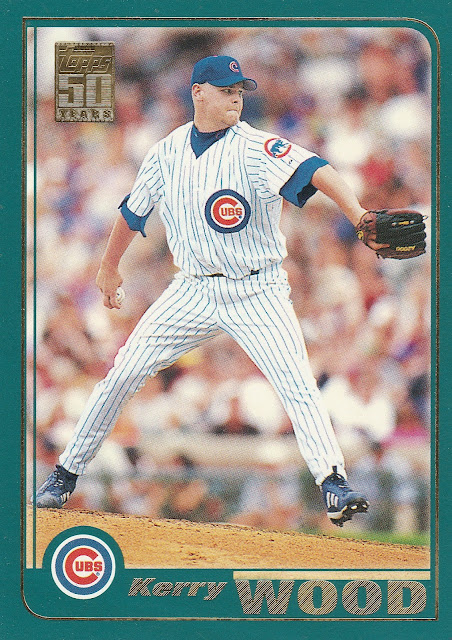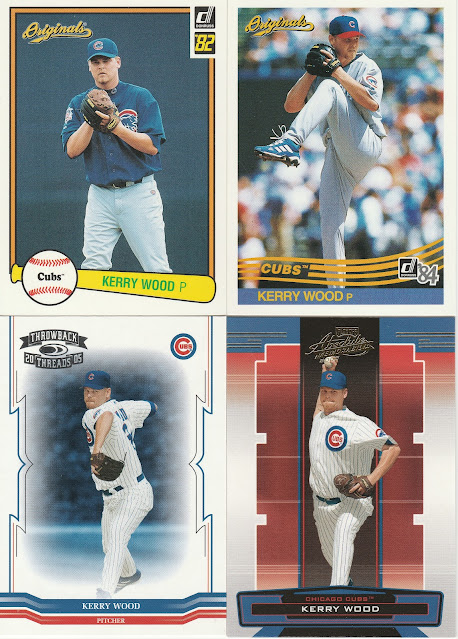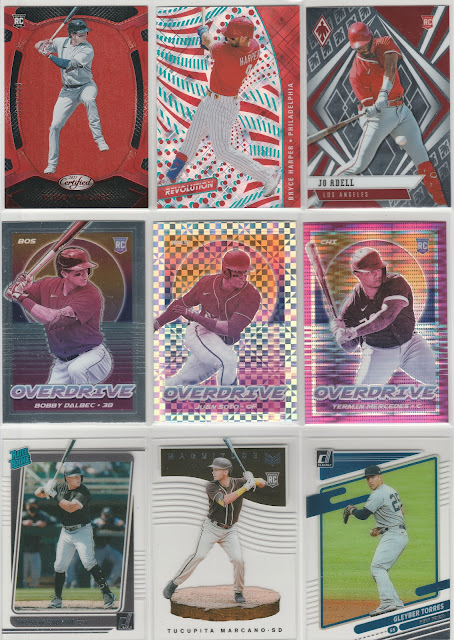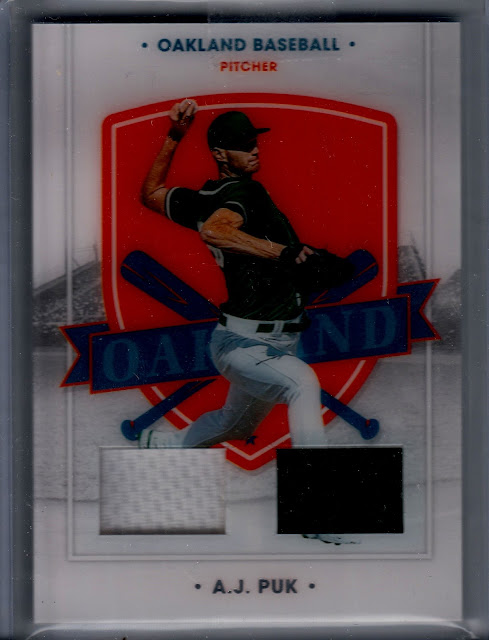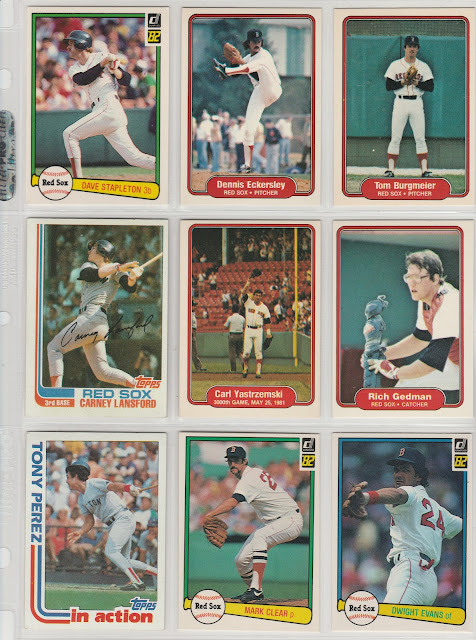This is a series of posts on a 1980's Frankenset. Each page features a different team, with 9 of my personal favorite cards from that year's team. You might find players repeated, you'll definitely see brands repeated, but hopefully you'll agree that there are some interesting selections from the 1980s!
1981 saw the Phillies attempt to repeat as National League and World Champions. A strong 2nd half vaulted the team into the playoffs, where they came up just short losing the 5th and final game of the NLDS to the Montreal Expos. During the year, Pete Rose passed Stan Musial as the National League's all time hits leader, and Steve Carlton recorded his 3,000th career strikeout. The individual accolades were nice, but the team had higher aspirations.

With the window to win starting to close for the veterans like Rose and Carlton, the team would make a few moves to try to make another championship run in 1982. They cut ties with 33 year old Bob Boone, turning to Ozzie Virgil Jr and Bo Diaz to be the new every(other)day catchers, traded for starting pitcher Mike Krukow to solidify the rotation, and decided to turn to veteran SS Ivan DeJesus to bolster the middle infield. None of these moves would prove fruitful in the long run, with the last trade suffering mightily in hindsight as the return for that investment in DeJesus was future Hall of Fame Second Baseman Ryne Sandberg and veteran Larry Bowa, who provided roughly the same production as DeJesus in 1982. Still a strong presence in the NL East, the Phillies would stay close all season but ultimately finish in 2nd place.
The Cards:Donruss #42 Steve Carlton - In 1982, Carlton was his usual superlative-laden self, winning the Cy Young Award (his 4th), on the back of a league leading 6 shutouts. He was also the NL's best with 23 victories, the last Phillie to win 20 games in the 20th Century, and led the NL in strikeouts for the 4th time. If you're more new school than old-school, you may be pleasantly surprised to know that not only were the counting stats good (Leading all NL pitchers in batters faced, innings pitched, complete games, and Games started), he also led the NL in FIP! Carlton was a no-doubt Hall of Fame case, pairing the 4 Cy Young awards with 2 World Championships. He was a 10 time All-Star, and is one of just 4 players in MLB history to surpass 4,000 career Strikeouts.
Fleer #251 Tug McGraw - McGraw was another of the Phillies 35+ year old veteran stars in the early 80s. Arguably his finest season came in 1980 as the 35 year old closer for the Phightin' Phils. He finished the regular season with a 1.46 ERA and an ERA+ of 260. He notched 20 saves, but finished another 28 games for the Phillies, striking out 75 batters. He was a member of the 1969 Miracle Mets (but did not pitch in the World Series), and an integral part of the 1980 World Champion Phillies. The 2 time All-Star was a solid to spectacular relief arm for nearly 20 seasons in the big leagues. He struck out nearly twice as many batters as he walked over more than 1,500 innings pitched. McGraw was best known for his signature pitch, a devastating screwball.
Topps #781 Pete Rose - Few players can lay claim to establishing a team's identity the way that Pete Rose did for the Phillies. They were a very good team in the mid to late 70s, but were often on the losing end of battles with in-state rivals the Pittsburgh Pirates as well as Rose's former team, the Big Red Machine Cincinnati Reds. When Rose left Cincy for Philly in free agency, the fortunes of both teams flipped. As mentioned above, Rose became the all time leader in hits in the National League in 1981, but more importantly, his style of play and leadership helped get the Phillies over the hump against their NL East rivals and win the 1980 World Series. The team hadn't been to the World Series in 30 years, and hadn't won a world series game since 1915! Rose changed that culture in Philadelphia.
Donruss #606 Lonnie Smith - Lonnie Smith is possibly the most underrated player of the 1980s. In the Phillies championship season, Smith led the team in Stolen Bases, but also sported an OPS+ of 130, finishing 3rd in Rookie of the Year voting. Used sparingly in 1980 and due to the strike-shortened 1981 season, his first full season would be 1982. He was traded to Saint Louis, where Smith would finally get the chance to play everyday. He was an All-Star and amassed 6.2 WAR, placing 2nd in the NL MVP race. He hit .307 with 68 Steals and scored a league leading 120 runs for the wild run and gun Cardinal offense that won the 1982 World Series. He'd win 3 World Series championships in the 1980s, for three different teams- the Phils in 1980, the Cardinals in 1982, and the Royals in 1985 - playing key roles on defense, at the plate, and on the bases. The last season of the decade was his best- leading the NL with 8.9 WAR, certainly an MVP worthy season. However, he compiled that season for the lowly Braves, finishing well out of contention and out of sight, out of mind for MVP voters. Time would catch up to Lonnie and his 1990s career paled in comparison to his 1980s numbers. He'd retire with a 118 OPS+, and a triple slash of .288/.370/.420. It amounted to a solid MLB career that doesn't get talked about that often.
Fleer #258 Mike Schmidt - Not too often do you see Schmidt sporting a full beard - nearly mistook him for Bill Walton! The Hall of Fame Third Baseman was right in the middle of his prime career years, the reigning NL MVP from 1980 and 1981. His 1982 season may have seen a slight dip in batting average, but he led the league (again) in OBP and Slugging. He was also right in the middle of a run of 9 consecutive Gold Gloves (he'd add one more before his career was over), and 5 straight Silver Slugger awards. In all, he'd be a 10 time All-Star, 10 Gold Gloves, 6 Silver Sluggers, 3 MVPs (80,81, and 86) and is generally regarded as one of the best third basemen of all time. He was the NL HR king 8 times, and his 548 career homers still ranks 16th, even after the steroid era saw 13 more members join the 500 HR Club.
Topps #581 Ron Reed - Reed's career in many ways is reminiscent of Dennis Eckersley in miniature. Reed started his career in the Braves rotation and was pretty good. He was an All-Star in 1968 as a rookie, and followed it up with an 18-10 record in 1969. Reed transition from the rotation to the bullpen in 1976 for the Phillies, and became a mainstay in their relief corps until after his 40th birthday. Reed was essentially the team's closer in 1982, saving 14 games and sported a 2.66 ERA over 57 appearances. For his career he started 236 games and finished 300 as a reliever. He faced over 10,000 batters and still had a better than league average ERA+ of 108. Fun fact about Ron Reed - before playing baseball, he played for the Detroit Pistons for 2 seasons, averaging 8 points and 6.4 rebounds a game.
Donruss #441 Gary Matthews - "Sarge" came to the Phillies after the 1980 World Championship season from Atlanta in exchange for the legendary Bob Walk. Matthews was known for a blend of power and speed and was extremely durable. He played all 162 games for the Phillies in 1982, and would go on to show his skills at their peak in the 1983 NLCS. His three homers against the Dodgers powered the "Wheeze Kids" to the 1983 World Series, earning him MVP honors in the process. Matthews was the 1973 Rookie of the Year and was an All-Star in 1979 with Atlanta. He'd go on to have a magical season with the Cubs in 1984, leading the NL in walks and OBP, scoring 101 runs to mark his career high. Matthews finished his career with 2,011 hits, 234 homers, and scored 1,083 runs.
Fleer #260 Manny Trillo -You have to be pumped when you can wear a "World Champions" patch on your jacket. Trillo was the Phils All-Star/Gold Glove/Silver Slugger winning second baseman in the early 80s, earning each accolade at least once between 1979 and 1982. Timely hitting in the 1980 NLCS made him the MVP of the Series. He hit .381 with 4 RBI for the Phils against Houston. He won all 3 of his Gold Gloves with the Phillies, but he was highly regarded for his defense throughout his career. He was best known for his rifle throwing arm, somewhat rare for a second baseman. His defensive prowess was so tantalizing that it was the subject of a controversy in Oakland during the team's three-peat in the mid 70s. In 1974, A's Owner Charlie Finley wanted Manny to be on the active roster so badly he tried to coerce infielder Mike Andrews to sign a statement saying he was injured to make room for Trillo on the roster. The move was met with a near team-wide mutiny, and it took a ruling from MLB Commissioner Bowie Kuhn to re-instate Andrews and restore peace in the locker room. Trillo was then traded after the 1974 series to the Cubs in exchange for Billy Williams.
Donruss #189 Sparky Lyle - Best known for his seasons in Yankee pinstripes. Lyle was a 16 year veteran pitching for elite teams in both leagues. He was a late season acquisition of the Phillies in 1980, and was not eligible for the post-season. His 14 innings of work down the stretch included a pair of saves and a miniscule 1.98 ERA. He's known as the first AL reliever to win a Cy Young award (1977), and one of the first to enter the game with a signature song playing to announce his arrival on the mound. (The same music used by High School graduations all over the country as well as Macho Man Randy Savage, "Pomp and Circumstance") Lyle credits Red Sox great Ted Williams with the advice that made him a big leaguer. Williams told him he'd never make it to the show without a slider. After perfecting the pitch in the minor leagues, Lyle would debut with Boston during the 1967 Impossible Dream Season. Lyle is quoted as saying "when Ted Williams told you something, you tried it."














